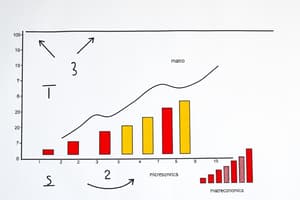Podcast
Questions and Answers
What is the primary focus of microeconomics?
What is the primary focus of microeconomics?
- The overall economy and national income
- Global trade dynamics
- Inflation and unemployment rates
- Individual consumers and businesses (correct)
What does opportunity cost represent in economic decision-making?
What does opportunity cost represent in economic decision-making?
- The cost of the next best alternative forgone (correct)
- The total cost incurred for a production
- The fixed costs associated with a project
- The minimum wage required for labor
Which economic system is characterized by centralized control where the government makes all decisions?
Which economic system is characterized by centralized control where the government makes all decisions?
- Traditional Economy
- Command Economy (correct)
- Market Economy
- Mixed Economy
What is the law of supply?
What is the law of supply?
Which indicator measures the total value of goods and services produced in a country over a specific time period?
Which indicator measures the total value of goods and services produced in a country over a specific time period?
What characterizes a monopoly in market structures?
What characterizes a monopoly in market structures?
What is the purpose of fiscal policy?
What is the purpose of fiscal policy?
What does comparative advantage refer to in international trade?
What does comparative advantage refer to in international trade?
Flashcards are hidden until you start studying
Study Notes
Key Concepts in Economics
1. Basic Definitions
- Economics: The study of how individuals and societies allocate scarce resources to satisfy unlimited wants.
- Scarcity: Limited availability of resources compared to the desire for them.
- Opportunity Cost: The cost of the next best alternative forgone when making a choice.
2. Microeconomics vs. Macroeconomics
- Microeconomics: Focuses on individual consumers and businesses, examining supply and demand, pricing, and market structures.
- Macroeconomics: Studies the economy as a whole, including inflation, unemployment, and national income.
3. Supply and Demand
- Law of Demand: As the price of a good decreases, the quantity demanded increases, and vice versa.
- Law of Supply: As the price of a good increases, the quantity supplied increases, and vice versa.
- Market Equilibrium: The point where supply equals demand, determining the market price and quantity.
4. Economic Systems
- Traditional Economy: Based on customs and traditions; often involves barter.
- Command Economy: Centralized control; government makes all economic decisions.
- Market Economy: Decisions made by individuals; prices determined by supply and demand.
- Mixed Economy: Combines elements of market and command economies.
5. Economic Indicators
- Gross Domestic Product (GDP): Total value of all goods and services produced in a country in a given time period.
- Unemployment Rate: Percentage of the labor force that is unemployed and actively seeking work.
- Inflation Rate: Rate at which the general level of prices for goods and services is rising.
6. Types of Markets
- Perfect Competition: Many buyers and sellers; homogeneous products; no barriers to entry.
- Monopoly: Single seller controls the entire market; unique product with no close substitutes.
- Oligopoly: Few sellers dominate the market; products may be identical or differentiated.
7. Fiscal and Monetary Policy
- Fiscal Policy: Government adjustments in spending and taxation to influence the economy.
- Monetary Policy: Central bank actions that manage the money supply and interest rates to control inflation and stabilize currency.
8. International Trade
- Comparative Advantage: The ability of a country to produce a good at a lower opportunity cost than another.
- Trade Barriers: Tariffs, quotas, and regulations that governments impose to restrict international trade.
- Balance of Trade: The difference between a country’s exports and imports.
9. Economic Theories
- Classical Economics: Belief in free markets and that economies are self-regulating.
- Keynesian Economics: Advocates for active government intervention to manage economic cycles.
- Supply-Side Economics: Focuses on boosting supply rather than demand, advocating for tax cuts and deregulation.
10. Current Trends
- Globalization: Increased interconnectedness of economies and cultures.
- Sustainable Economics: Focus on long-term ecological balance and sustainability in economic decisions.
- Digital Economy: Impact of technology and the internet on economic activities, including e-commerce and cryptocurrencies.
Basic Definitions
- Economics: Studies allocation of limited resources to satisfy infinite wants.
- Scarcity: Refers to the limited availability of resources versus the demand for them.
- Opportunity Cost: Represents the value of the next best alternative that is not chosen.
Microeconomics vs. Macroeconomics
- Microeconomics: Analyzes individuals and businesses, focusing on supply and demand, pricing strategies, and market dynamics.
- Macroeconomics: Evaluates the overall economy, including factors such as inflation rates, employment levels, and national income statistics.
Supply and Demand
- Law of Demand: Indicates that as prices decrease, the quantity demanded increases, and vice versa.
- Law of Supply: Suggests that higher prices lead to greater quantities supplied, while lower prices reduce supply.
- Market Equilibrium: Status where supply matches demand, establishing the market price and quantity sold.
Economic Systems
- Traditional Economy: Operates on historical customs, often utilizing barter rather than currency.
- Command Economy: Characterized by centralized decision-making, where the government controls economic activity.
- Market Economy: Driven by individual choices, with prices determined through supply and demand interactions.
- Mixed Economy: Integrates features from both market and command economies for a balanced approach.
Economic Indicators
- Gross Domestic Product (GDP): Measures total output of goods and services produced in a country within a specified time frame.
- Unemployment Rate: Percentage of the workforce that is actively seeking employment but unable to find work.
- Inflation Rate: Indicates how quickly prices for goods and services rise within an economy.
Types of Markets
- Perfect Competition: Exhibits many buyers and sellers, with uniform products and minimal barriers to market entry.
- Monopoly: A market controlled by a single seller offering a unique product with no close substitutes.
- Oligopoly: Characterized by a few large firms that dominate the market, with products that may either be similar or distinct.
Fiscal and Monetary Policy
- Fiscal Policy: Government strategies regarding spending and taxation to influence economic conditions.
- Monetary Policy: Actions taken by central banks to regulate money supply and interest rates, aiming to control inflation and stabilize the economy.
International Trade
- Comparative Advantage: Describes a country's ability to produce goods more efficiently at lower opportunity costs than its trade partners.
- Trade Barriers: Include measures like tariffs and quotas imposed by governments to limit foreign trade.
- Balance of Trade: Measures the difference between a country's exports and imports, indicating trade performance.
Economic Theories
- Classical Economics: Emphasizes the effectiveness of free markets and the self-regulating nature of economies.
- Keynesian Economics: Supports government intervention as necessary to correct economic fluctuations and foster stability.
- Supply-Side Economics: Prioritizes increasing supply through tax reductions and deregulation to stimulate economic growth.
Current Trends
- Globalization: Enhances economic and cultural interconnections across nations, promoting trade and migration.
- Sustainable Economics: Focuses on integrating ecological considerations into economic decision-making for long-term sustainability.
- Digital Economy: Examines the effects of technology on commerce, encompassing aspects like e-commerce and digital currencies.
Studying That Suits You
Use AI to generate personalized quizzes and flashcards to suit your learning preferences.




